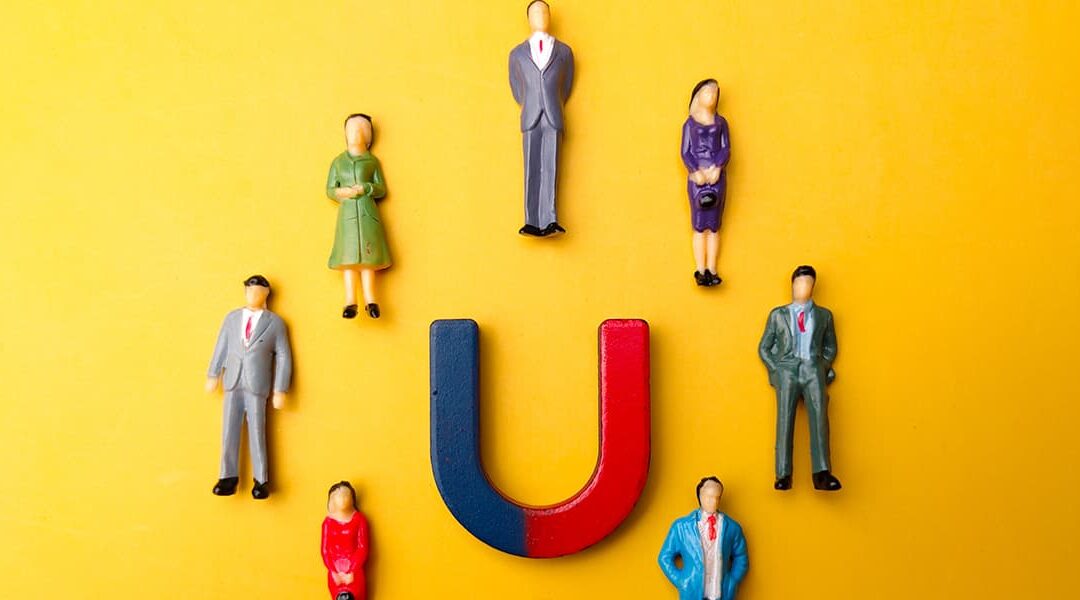If you’re like me, you love listening to music. At work, on the road, at home—wherever you are, you bring your platform of choice along with you. And if you listen for prolonged sessions, you probably hate it when the album or playlist you’re listening to is disrupted by an advertisement pitching something to you that you have no interest in.
These ads are disruptive, annoying, and may even repel you away from the service being provided rather than propel you toward it. With increased digitization and social media use, deciding what, when, and from whom to buy now lie entirely in the hands of the customer.
With so much power over how they consume media, customers have evolved in the way in which they are advertised to. In short, the customer now decides when they want to be advertised to. Disruptive, in-your-face advertising simply does not appeal and does little to advance the customer’s buyer’s journey.
“There must be better way, then,” I can hear you say.
Thankfully, there is. This way is a methodology known as inbound marketing. And the benefits of inbound marketing are numerous, which is why I’d like to present these advantages to you today.
Outbound vs Inbound Marketing: A Primer
Let’s take a moment to understand the fundamental difference between traditional outbound marketing and the inbound marketing approaches. Before we do, though, it should be stated that the purpose of this article is not to dismiss outbound marketing as some archaic approach which has no place in modern advertising.
On the contrary, there is no one-size-fits-all approach to your marketing strategy. In the marketing sphere—especially as it pertains to digital marketing—we sometimes think of our jobs as a grand experiment of setting up a strategy: identifying your goals, the variables, and a method of measurement. Then, we see which parts of the strategy bring you the results you want, optimize those parts, identify what isn’t working, and make the adjustments needed to improve performance.

One of the benefits of inbound marketing is the relationships only the inbound approach can form!
In other words, there is no silver bullet approach guaranteed to bring instant success. Often, the best results come about as a combination of inbound and outbound marketing.
Outbound Marketing
Traditional outbound marketing involves actively seeking out potential customers through paid advertising, cold calling, direct mail campaigns, and other forms of promotion.
Think of outbound as a volume play: when you push your message out to the largest audience money can buy, chances are you’ll capture the attention of a subset of that audience, and that subset can potentially become customers.
Outbound marketing does have its uses in certain scenarios, such as when targeting a broad audience of people who are not aware of your product or service. For example, businesses promoting a new product may advertise on billboards or TV commercials to create awareness and generate interest.
However, outbound marketing can be less effective when targeting a more specific audience or when trying to generate qualified leads. Spamming potential customers with unsolicited messages, for example, leads to a negative perception of your brand and reduces the chances of converting leads into customers.
Inbound Marketing
Inbound marketing thrives in scenarios where businesses aim to connect with their target audience on a personal level while addressing their unique challenges. For example, in industries where buyers conduct extensive research before making purchasing decisions, such as software, manufacturing, or professional services, inbound marketing can be highly effective.
By creating informative blog posts, whitepapers, and case studies, businesses position themselves as trusted advisors, so people who are actively seeking solutions to their problems turn to the experts to help them resolve them. The result? A CRM full of leads who are looking for the exact solutions you provide.
However, there are cases in which inbound marketing might present challenges. Industries with limited online presence, may struggle to reach their target audience through digital channels alone. This is where the previously mentioned hybrid approach, combining the traditional outbound approach and inbound marketing tactics may be necessary.

Business blogging is at the core of inbound marketing because it helps attract visitors to your website.
Moreover, certain time-sensitive campaigns, such as limited-time promotions or urgent offers, may not align seamlessly with the long-term relationship-building nature of inbound marketing.
Top 10 Benefits of Inbound Marketing
If you’re interested in learning more about inbound marketing—or even considering implementing it into your business’ promotional arsenal, you will undoubtedly want to know what the benefits the approach has to offer your organization.
Let’s take a look at 10 benefits of inbound marketing:
1. Customers Reach You When They’re Ready
Unlike traditional outbound methods that interrupt customers with unwanted messages, the inbound marketing approach empowers prospective customers to reach you and your organization only when they want to—specifically when they’re actively looking for your solutions.
By creating valuable content, optimizing your website for search engines, and engaging on social media platforms, you position your business as a trusted resource within your industry.
As a result, you attract customers who are already interested in what you have to offer, increasing the likelihood of conversions and maximizing your marketing efforts.
2. Increased Brand Awareness
When your organization consistently produces high-quality and valuable content, you establish your brand as a thought leader within your industry.
Sharing your expertise in blog articles, videos, eBooks, and social media helps to position your business at the forefront of your customers’ minds.
As your target audience engages with your content and recognizes the value you provide, your brand gains visibility and credibility. This increased awareness not only attracts new customers but also fosters loyalty among existing customers.
3. Quality Traffic and Leads
One of the greatest advantages of inbound marketing is its ability to generate quality traffic and leads. By aligning your content with the needs and interests of your target audience, you attract those people who are most likely to become leads, and then customers.
Inbound marketing tactics such as search engine optimization (SEO), targeted social media campaigns, and lead generation forms on your website help capture your audience members’ attention. Since you know the type of people who are interested in your content, those who interact and convert on your content are—to a reasonable extent—prequalified marketing leads.

The inbound methodology attracts more visitors to your website over time and brings higher quality leads.
By focusing on creating quality content, you can maximize your resources and ensure your sales team spends their time engaging with the leads who are most likely to convert.
4. A More Personalized Approach
When you create tailored content and use the right marketing automation tools, you can deliver the right message to the right person at the right time.
Understanding your target audience’s pain points and preferences enables you to provide relevant solutions that resonate with their needs.
Personalized experiences and interactions build trust and loyalty. This is because such experiences let customers know your organization understands them and values them. Think about it: when your sales and service teams provide exceptional service and great experiences—giving the customer everything they need and nothing they don’t—the relationship grows stronger, and they’re more likely to become repeat customers and/or refer their peers with similar problems to you.
It’s the same at the top of the funnel, too! When prospective customers feel understood and valued, you relate to them, they relate to you, and they are more willing—even excited—to turn to you for help.
5. Marketing, Sales, and Service Teams Align
On that note, the inbound approach also helps all your customer-facing departments align their efforts to serve your clients. The result? A seamless customer experience!
Whether your marketing team is attracting your customers, your sales team is engaging them through their buyer’s journey, or your service team is delighting them with continued excellence, the inbound methodology means your customers enjoy a consistent experience with everyone on your team.
How does it work?
When they share insights and feedback, teams collaborate to better understand customer needs and preferences. This alignment allows for more targeted and effective marketing campaigns, ensures consistent messaging throughout the buyer’s journey, and enables sales and service teams to answer questions and provide support. This leads to a unified approach where customer satisfaction is the objective.

Inbound marketing represents an opportunity to reach your prospects where they are.
6. Educate Your Audience
Your customers are not mindless robots! They are people with a problem they want to solve. Typically, when people have a problem, they’ll either try to solve it by themselves or find someone who can help them.
Inbound marketing is an excellent tool for educating your audience. The inbound approach features the creation of valuable and informative content to prospective clients. When you do this, you position yourself as an industry expert who is willing to share knowledge and insights.
We’ll expand on this shortly, but educating your audience helps to build trust and credibility and establishes your business as a go-to resource for information. Through blog posts, whitepapers, webinars, and educational videos, you address your reader’s questions and help them navigate their challenges.
7. Trust and Credibility
Trust and credibility are crucial for continued business growth, and inbound marketing excels at building both. Inbound and content marketing are all about consistently delivering valuable and authentic content to your audience. Doing so positions your organization as a reliable source of information and solutions.
By creating content that educates, informs, and addresses the pain points of your target audience, you demonstrate your expertise and commitment to providing value to them.
Sharing success stories, customer testimonials, and positive reviews further enhances your reputation and fosters trust among potential customers.
8. Long-Term Customer Loyalty
You guessed it! The inbound approach also helps you maintain customer loyalty. Establishing trust and credibility are essential for both attracting new customers and for retaining your current customers.

The only thing better than new customers are returning customers. A holistic inbound approach will reach both.
By consistently engaging with your audience through personalized content, social media interactions, and excellent customer service, you establish and maintain a connection with them which transcends mere transactions (though, a strong sense of loyalty and repeat business is undeniably a bonus).
Satisfied customers are more likely to become advocates for your organization and refer your business to others. So, we can see, through customer satisfaction, you build a loyal base which can be a springboard for your business’ success.
9. Built to Last
Inbound marketing provides a sustainable long-term strategy for business growth. By creating evergreen content for your personas and optimizing your website for search engines, your content continues to attract and engage potential customers long after it is published.
Rather than relying on one-time ad campaigns, inbound marketing’s sustainable approach is the spring of the stream of traffic, leads, and conversions. Over time, the stream will grow stronger and become a river!
This sustainability enables your business to build a strong online presence and establish a solid foundation for consistent growth, even in the face of changing market dynamics.
10. Cost Effectiveness
Another benefit of inbound marketing compared to its more traditional counterpart is its cost-effectiveness. Inbound’s focus on organic content creation, search engine optimization, email marketing, and social media engagement requires fewer financial resources than traditional advertising methods.
In fact, Constant Contact found that after 5 months of consistent inbound marketing are 80% less expensive than outbound leads. They also found the average cost per lead is 60% less expensive than outbound generated leads.

The inbound approach is all about creating relationships built to last. It’s also a more cost effective approach.
Because the inbound approach is more cost-effective, the return on investment is greater. Additionally, the targeted approach of inbound marketing ensures resources are allocated to reaching the most qualified leads, further maximizing cost efficiency.
All this together means businesses can allocate their marketing budget strategically and achieve impactful results without breaking the bank.
Where Will Your Inbound Marketing Journey Take You?
Are you frustrated spending more money for lower quality leads? Are you ready for your organization to thrive through long-term, sustainable growth?
If so, the inbound marketing approach and the benefits it brings with it may be the secret ingredient you’ve been looking for!
Every sector and every business is unique, though, so they require strategies that are as unique as they are to bring the success they need. So, how can you decide which strategy is best for you and put the plan into action?
There are several techniques, but the key is to have a marketing professional on your team who understands different approaches and knows what levers to push and pull (and when) to bring your organization continued success.
![20250616_SPW_SEOSmallBizGuideCTA • Sharp Wilkinson Boost Your Online Visibility! Unlock the secrets to a top-ranking website with our FREE SEO Guide for Small Businesses. [Download Your Guide Now!]](https://sharpwilkinson.com/wp-content/uploads/2025/06/20250616_SPW_SEOSmallBizGuideCTA-1024x512.png)





